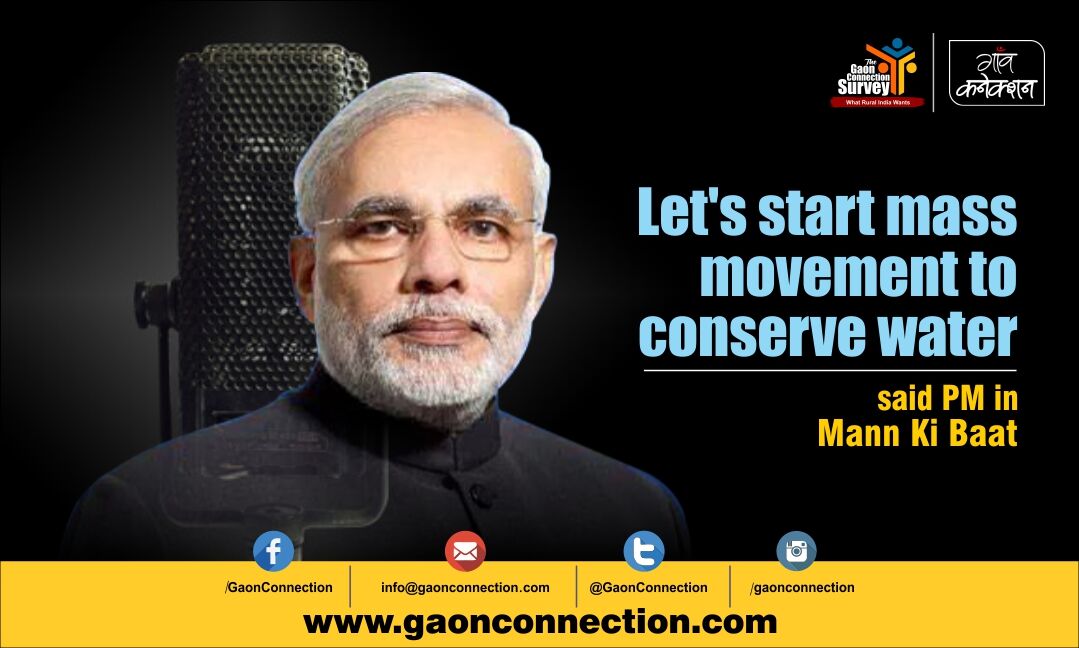In Mann Ki Baat 2.0, PM Modi stresses on conserving water
In his first Mann Ki Baat after being re-elected, the Prime Minister Narendra Modi called for water conservation measures across the country to deal with the growing water crisis.The recent Gaon Connection Survey has startling facts on water availability in rural India that support Modi's call
 गाँव कनेक्शन 2 July 2019 7:41 AM GMT
गाँव कनेक्शन 2 July 2019 7:41 AM GMT

Only 8 per cent interviewed rural households had piped water supply
Over 35 per cent rural women walk up to half a kilometer to fetch water
Over 41 per cent farmers demanded better irrigation facilities to improve farming
In his first Mann Ki Baat after being re-elected, the Prime Minister Narendra Modi called for water conservation measures across the country to deal with the growing water crisis.
In his radio address on June 30, Modi said that only eight per cent of the water that falls on the country as rain gets harvested. On the other hand, large parts of the country face water scarcity every year. The Prime Minister called upon the 130 crore citizens of the country to join hands and adopt water conservation measures to find a solution to the prevailing water crisis. He also said that there can be no one solution to the water problems in the country. Each region will have to adopt its own water conservation methods, but the ultimate goal remains the same — saving water.
Modi informed that water is a priority in the country, hence Union Ministry of Jal Shakti has been set up, which will take quick decisions on water related matters in the country. The Prime Minister has already sent letters to all the gram pradhans (village heads) to harvest every drop of rain that falls from the sky, and discuss methods of conserving water with the local villagers by holding regular gram sabhas.
Incidentally, last week, Gaon Connection, India's largest rural media network, released findings of its unique rural survey carried out in 19 states of the country where villagers were interviewed on various issues ranging from farming to water to livelihood to cattle to sanitation, etc.
Survey findings show the daily battle rural women have to face to fetch drinking water. The Gaon Connection Survey found that over 35 per cent of the rural women have to walk up to half a kilometer to fetch water.
For instance, Maalti lives in Satna district, which is 350 km from Vidisha in Madhya Pradesh. She has to walk for one kilometer to fetch water.
Rural children are suffering, too. Ten-year-old Mohit, who lives in Chakraghunathpur village in Vidisha, daily reaches school late because he has to walk one kilometer to fetch water, twice in a day.
Another startling fact that emerged out of the Gaon Connection Survey was that only eight per cent of the interviewed households had piped water supply. The rest had to source their daily water from public stand posts, dug wells, hand pumps, ponds, etc. For instance, 36.6 per cent of the interviewed families were dependent on public stand posts for their water supply, and over 25 per cent used hand pumps.
The third important point that emerged out of the Gaon Connection Survey is with regards to water for irrigation. When as part of the survey, farmers were asked what was needed to improve farming, maximum respondents — 41.4 per cent — demanded better irrigation facilities.
This fact gains importance in the present scenario when over 45 per cent area in the country is facing drought conditions with about 11 per cent facing 'extreme dry' and 'exceptional dry' conditions, as recorded in the South Asia Drought Monitor maintained by the Indian Institute of Technology Gandhi Nagar.
Farming situation is grim in the country as the southwest monsoon, on which a large chunk of farmers depend for sowing, is delayed. As per the India Meteorological Department, area-wise 82 per cent area of the country has had deficient or large deficient rainfall in the first month of the monsoon.
It is imperative that each drop of rain that falls from the sky needs to be harvested.
A day after Modi's call for water harvesting, Union Jal Shakti Minister Gajendra Singh Shekhawat launched 'Jal Shakti Abhiyan' on July 1 with focus on 1,592 water-stressed blocks in 256 districts. This abhiyan has five components: water conservation and rainwater harvesting, renovation of traditional and other water bodies, reuse and recycle of water, watershed development, and intensive afforestation.
If implemented in both letter and spirit, and with active participation of the people, a decentralized water conservation programme can turn around the water scenario of the country, and for the good.
More Stories




